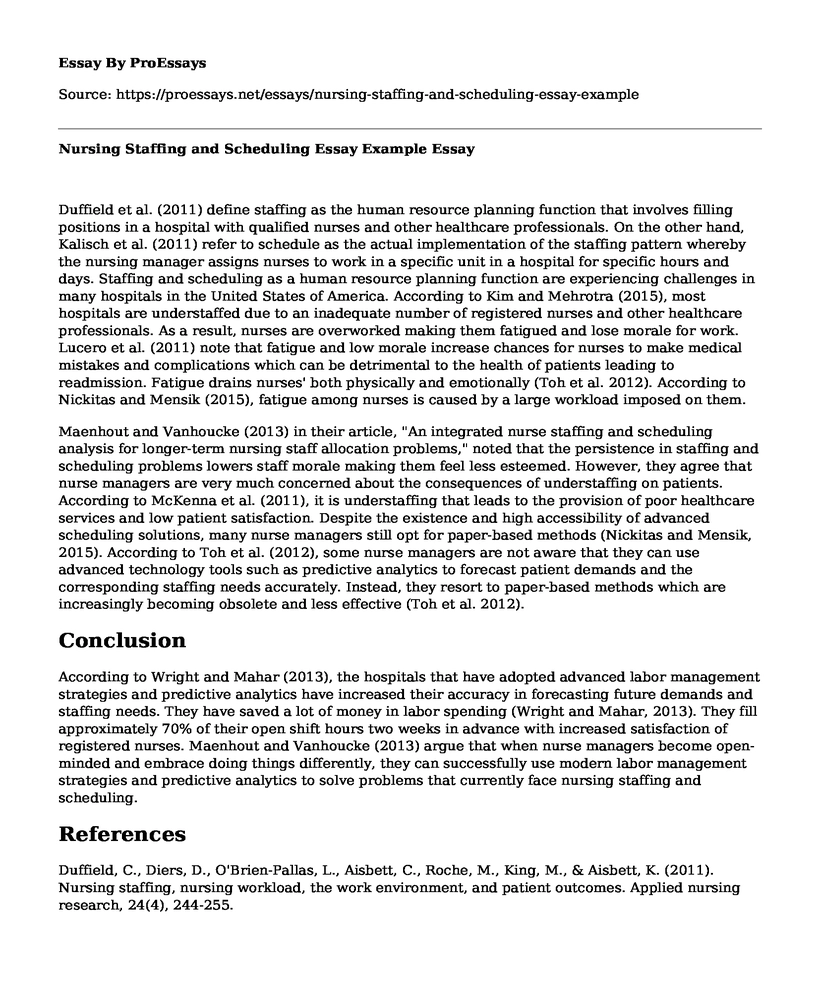Duffield et al. (2011) define staffing as the human resource planning function that involves filling positions in a hospital with qualified nurses and other healthcare professionals. On the other hand, Kalisch et al. (2011) refer to schedule as the actual implementation of the staffing pattern whereby the nursing manager assigns nurses to work in a specific unit in a hospital for specific hours and days. Staffing and scheduling as a human resource planning function are experiencing challenges in many hospitals in the United States of America. According to Kim and Mehrotra (2015), most hospitals are understaffed due to an inadequate number of registered nurses and other healthcare professionals. As a result, nurses are overworked making them fatigued and lose morale for work. Lucero et al. (2011) note that fatigue and low morale increase chances for nurses to make medical mistakes and complications which can be detrimental to the health of patients leading to readmission. Fatigue drains nurses' both physically and emotionally (Toh et al. 2012). According to Nickitas and Mensik (2015), fatigue among nurses is caused by a large workload imposed on them.
Maenhout and Vanhoucke (2013) in their article, "An integrated nurse staffing and scheduling analysis for longer-term nursing staff allocation problems," noted that the persistence in staffing and scheduling problems lowers staff morale making them feel less esteemed. However, they agree that nurse managers are very much concerned about the consequences of understaffing on patients. According to McKenna et al. (2011), it is understaffing that leads to the provision of poor healthcare services and low patient satisfaction. Despite the existence and high accessibility of advanced scheduling solutions, many nurse managers still opt for paper-based methods (Nickitas and Mensik, 2015). According to Toh et al. (2012), some nurse managers are not aware that they can use advanced technology tools such as predictive analytics to forecast patient demands and the corresponding staffing needs accurately. Instead, they resort to paper-based methods which are increasingly becoming obsolete and less effective (Toh et al. 2012).
Conclusion
According to Wright and Mahar (2013), the hospitals that have adopted advanced labor management strategies and predictive analytics have increased their accuracy in forecasting future demands and staffing needs. They have saved a lot of money in labor spending (Wright and Mahar, 2013). They fill approximately 70% of their open shift hours two weeks in advance with increased satisfaction of registered nurses. Maenhout and Vanhoucke (2013) argue that when nurse managers become open-minded and embrace doing things differently, they can successfully use modern labor management strategies and predictive analytics to solve problems that currently face nursing staffing and scheduling.
References
Duffield, C., Diers, D., O'Brien-Pallas, L., Aisbett, C., Roche, M., King, M., & Aisbett, K. (2011). Nursing staffing, nursing workload, the work environment, and patient outcomes. Applied nursing research, 24(4), 244-255.
Kalisch, B. J., Tschannen, D., & Lee, K. H. (2011). Do staffing levels predict missed nursing care?. International Journal for Quality in Health Care, 23(3), 302-308.
Kim, K., & Mehrotra, S. (2015). A two-stage stochastic integer programming approach to integrated staffing and scheduling with application to nursing management. Operations Research, 63(6), 1431-1451.
Lucero, R. J., Ji, H., de Cordova, P. B., & Stone, P. (2011). Information technology, nurse staffing, and patient needs. Nursing Economics, 29(4), 189-195.
Maenhout, B., & Vanhoucke, M. (2013). An integrated nurse staffing and scheduling analysis for longer-term nursing staff allocation problems. Omega, 41(2), 485-499.
Maenhout, B., & Vanhoucke, M. (2013). Analyzing the nursing organizational structure and process from a scheduling perspective. Health care management science, 16(3), 177-196.
McKenna, E., Clement, K., Thompson, E., Haas, K., Weber, W., Wallace, M., ... & Hershiser, L. (2011). Using a nursing productivity committee to achieve cost savings and improve staffing levels and staff satisfaction. Critical Care Nurse, 31(6), 55-65.
Nickitas, D. M., & Mensik, J. (2015). Exploring nurse staffing through excellence: A data-driven model. Nurse Leader, 13(1), 40-47.
Toh, S. G., Ang, E., & Devi, M. K. (2012). A systematic review on the relationship between the nursing shortage and job satisfaction, stress and burnout levels among nurses in oncology/hematology settings. International Journal of EvidenceBased Healthcare, 10(2), 126-141.
Wright, P. D., & Mahar, S. (2013). Centralized nurse scheduling to simultaneously improve schedule cost and nurse satisfaction. Omega, 41(6), 1042-1052.
Cite this page
Nursing Staffing and Scheduling Essay Example. (2022, Dec 06). Retrieved from https://proessays.net/essays/nursing-staffing-and-scheduling-essay-example
If you are the original author of this essay and no longer wish to have it published on the ProEssays website, please click below to request its removal:
- Nursing Essay Example: Moral and Ethical Principles in Nursing
- Influence of Ethnicity on Minority Health and Wellbeing Experiences
- Advances in Polio Vaccine Technology and History of Polio Vaccine Technology - Research Paper
- Essay Sample on Nursing and Social Media Use at Work
- The Journey to Public Health: A Grandmother's Legacy - Essay Sample
- Scientific Rigor: A Value in Nursing for Evidence-Based Thinking - Essay Sample
- Alcohol & Memory Loss: Research Paper







